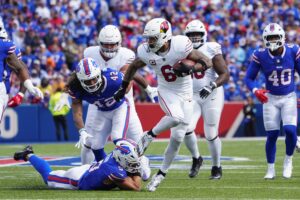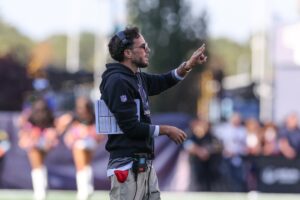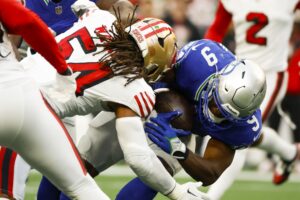The NFL’s draft process is the pillar of the offseason. It gives fans something to be excited about during the summer when most leagues are on break. The excitement around incoming prospects is often followed by disappointment when said prospects bust. How do we identify wide receiver busts before wasting fantasy football draft picks or emotional equity on them?
How to Find Wide Receiver Busts
The Criteria
The criteria for being considered a ‘bust’ are as follows. For starters, to be called a ‘bust’ assumes that there were high expectations in the first place. Because of that, we’ll only be looking at wide receivers drafted in the first round of the NFL draft.
Measuring individual success in the NFL is challenging. But at the wide receiver position, receiving yards is as good of an indicator as any stat. With that said, the benchmark is 600 receiving yards in a season. In other words, if a receiver can’t average 35 receiving yards per game, they’re considered a ‘bust.’
Additionally, 2023 rookies will be excluded from this list. They haven’t had enough time to show what they can or can’t do. You’re welcome, Quentin Johnston.
Here are the last nine receivers drafted in the first round who haven’t reached 600 yards in a season:
- John Ross (9th overall pick in 2017)
- N’Keal Harry (32nd overall pick in 2019)
- Henry Ruggs (12th overall pick in 2020)
- Jalen Reagor (21st overall pick in 2020)
- Kadarius Toney (20th overall pick in 2021)
- Rashod Bateman (27th overall pick in 2021)
- Jameson Williams (12th overall pick in 2022)
- Jahan Dotson (16th overall pick in 2022)
- Treylon Burks (18th overall pick in 2022)
After crunching the numbers, all the wide receivers listed above fall into one of two groups. Except for John Ross.
Small Fish in Big Ponds
The first group features Henry Ruggs, Kadarius Toney, and Jameson Williams. The data shows that each of these receivers was a ‘system’ player, if you will. These receivers were a small part of a highly functioning offense in college and benefitted from surrounding talent.
In 2019, Henry Ruggs was a part of an Alabama offense flooded with NFL talent. Ruggs played with future Heisman trophy winner DeVonta Smith, two NFL quarterbacks in Tua Tagovailoa and Mac Jones, and further notables like Jaylen Waddle and Najee Harris. This Alabama offense scored the 2nd most points per game in the nation. Ruggs only played a small part in this, receiving an underwhelming 14.3% target share.
This also applies to Jameson Williams, who transferred to Alabama after being a non-factor at Ohio State. Williams’ 20.7% target share is noticeably better than Ruggs, but nothing special for a first-round receiver. Once again, the Crimson Tide wound up as one of the highest-scoring teams in the nation. Williams deserves credit for this, but he was far from the only contributor.
Lastly is Kadarius Toney, who probably shouldn’t have been a first-round pick in the first place. His breakout season at Florida didn’t come until his senior year. Even then, he failed to reach 1,000 receiving yards and saw an 18% target share. Although Florida finished 13th in the nation in points per game, it was another collaborative effort. Future NFL players like Kyle Pitts, Dameon Pierce, and Kyle Trask each elevated this offense.
It’s worth noting that these players have similar traits. They’re all speedsters who provide value by threatening to take the top off a defense on any given play. While this is valuable in real life, it’ll rarely help your fantasy team.
Big Fish in Small Ponds
The second group of prospects is the polar opposite of the first group. These players dominated their respective collegiate offenses, which sounds more impressive than it is. This group includes N’Keal Harry, Jalen Reagor, Rashod Bateman, Treylon Burks, and Jahan Dotson.
N’Keal Harry was far and away the alpha in Arizona State’s receiver room. Harry was responsible for over 1/3 of the team’s receiving yards and nearly half of the receiving touchdowns. However, his only competition for targets was Brandon Aiyuk, who had just transferred from a junior college.
There’s no need to break down every player in this section. According to the numbers, they’re all just N’Keal Harry. They each dominated a subpar offense without NFL talent to compete with for opportunities.
The highest scoring offense any of these players was apart of was Treylon Burks in 2021. Even then, Arkansas was barely a top 50 school in points per game.
Harry, Reagor, Bateman, Burks, and Dotson were much better than their teammates, but shouldn’t have been drafted highly because of that. Dominating as an NFL wide receiver is much different than dominating at a school like TCU or Arizona State.
John Ross
John Ross is on his own here. He was phenomenal at the University of Washington, scoring 17 touchdowns in his final season. Ross also accounted for roughly a third of the Huskies’ passing yards. He played with future NFLers like Jake Browning, Dante Pettis, Myles Gaskin, and Will Dissly and still took the lions share of opportunites. The Huskies even finished 8th in the nation that year in points per game.
John Ross had everything going for him, yet he disappointed in the NFL. Of course, much of this has to do with unlucky injuries, but it also shows the unpredictable nature of prospects.
Bottom Line on Wide Receiver Busts
If there’s anything to take away from this research, dig deeper than surface-level numbers. Even analytics and advanced stats can be useless without context. Consider the environment around a wide receiver and how it affected his stats, for better or worse.
Watch: Ladd McConkey Film Study
Main Photo Credit: Denny Medley-USA TODAY Sports






